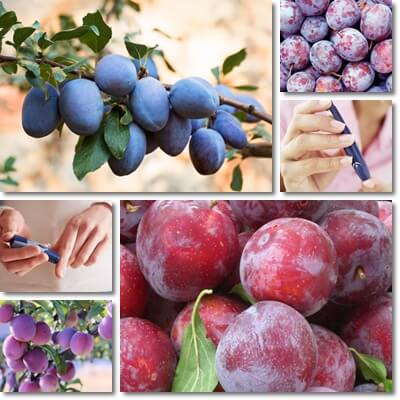Yes, you can eat plums if you have diabetes, but in limited amounts, as part of an overall clean, balanced and varied diet tailored to the individual nutritional requirements and restrictions of your condition. On average, 100 g of plums provides 11.42 g of total carbohydrates, 9.92 g of which are simple sugars. Fortunately, plums have a low glycemic index of only 40 and a low glycemic load of 5, meaning their effects on blood sugar levels are minimal when consumed in moderate amounts. To further reduce the effects of plums on blood sugar metabolism, you can pair them with a source of protein and fat such as a small piece of cheese or some plain yogurt or eat them after a light protein, low-carbohydrate meal.
Basically, the goal for diabetics is to have a moderate carbohydrate intake, which includes sugar (also a carbohydrate). What happens when a diabetic and non-diabetic eat a food like a fruit or vegetable which contains carbohydrates is their body breaks down the carbohydrates into their simplest form, sugar. Next, the pancreas produces the hormone insulin to help move the sugar from the bloodstream and into liver, muscle and fat cells.

But because the diabetic patient suffers from either an insufficient production of insulin or their cells are not as responsive to insulin as those of a non-diabetic, they can’t process eating too much carbs at once.
Too much carbs raise blood sugar levels too high too quickly and overwhelm the body. So diabetics need to reduce carbohydrate intake per day and per meal. Ideally, they should see a doctor or dietitian for a personalized eating plan that includes recommendations for carbohydrate intake per day and per meal (maybe also a separate recommendation for maximum sugar intake).
Are plums ok for diabetics?
Generally speaking, plums and diabetes are a good pair since the raw fruit is a moderate source of carbohydrates and sugar and also contains fiber which slows down the absorption of sugar into the bloodstream. The fruit also has a low glycemic index and a low glycemic load which means it doesn’t raise blood sugar levels too high too fast, provided it is consumed mindfully, in limited amounts. Overall, fresh plums are usually well tolerated in the diets of most diabetic patients.
How many carbs and how much sugar in plums?
100 g of fresh plums has an average of 9.92 g of sugar out of a total of 11.42 g of carbohydrates (sugar is a carbohydrate). The remaining of 1.4 g consists of dietary fiber, which is an indigestible carbohydrate. Compared to other fruit, plums are not necessarily high in sugar, but rather a moderate source. They have about as much sugar as pears (9.75 g/100 g of fruit), apples (10.4 g) and pineapple (10 g) but more than cantaloupe (7.86 g), watermelon (6.2 g) and strawberries (4.89 g) and less than banana (12.23 g), cherries (12.82 g), mango (13.66 g), pomegranate (13.67 g), grapes (15-16 g) and figs (16.26 g).

But with diabetes, it’s not just about how much sugar is in plums (9.92 g/100 g of fruit). It’s also about how fast that sugar is absorbed into the bloodstream. And that can be determined by what are known as glycemic index and glycemic load. And both of these factors say that fresh plums are just as good for diabetes as pears, apples, strawberries and cherries and better fruits than cantaloupe, watermelon and even mango.
Plums glycemic index: low (40)
The glycemic index (GI) is a scale that measures how fast the carbohydrates from plant foods raise blood sugar levels (because carbohydrates are broken down into simple sugars during digestion, except indigestible ones like fiber). Below 55 is a low GI. Between 55-69 is a moderate GI. Between 70-100 is a high GI. Diabetics are advised to choose fruits and other plant foods with a low GI, such as fresh plums which have a glycemic index of 40. When consumed in moderate amounts, they have minimal effects on blood sugar metabolism.
By comparison: pears with skin (glycemic index: 38, low), apples with skin (glycemic index: 39, low), strawberries (40, low), fresh figs (between 35-40, low, depending on variety and degree of ripeness which determines sugar content). Even grapes, mango and cherries have a low GI, despite their significant sugar content. So it’s not just about how much sugar is in plums, but also about how it’s metabolized.
Plums glycemic load: 5.6 (low)
The glycemic load (GL) is a scale that measures how a serving of a fruit or other plant food raises blood sugar levels. Below 10 is a low GL. Between 10-19 is a moderate GL. Over 20 is a high GL. Plums (the fresh kind) have a glycemic load score of 5.6, estimated at 6 (low). Ideally, diabetics should choose foods with a low GL such as plums, but also apples, pears or strawberries which don’t generate significant rises in blood sugar levels.
Are dried plums high in sugar?
Yes, they are rather high in it actually. Dried plums are more than 1/3 sugar. 100 g of raw, dried plums provides approximately 63.88 g of carbohydrates of which 38.13 g are simple sugars and only 7.1 g dietary fiber. So in addition to the 38.13 g of sugar, they also provide an additional 18.65 g of digestible carbohydrates which are also broken down into simple sugars. As a result of their nutritional profile (high carbohydrate content), the dried fruit also have a high glycemic index. Overall, it’s better to avoid dried plums (prunes) with diabetes.
Benefits of fresh plums for diabetes include:
1) Minor benefits for wound healing due to good vitamin C content (9.5 mg per 100 g of fruit).
2) Minor benefits for skin and diabetes-associated nerve damage from varied B vitamin profile (vitamins B1, B2, B3, B5, B6, B9), vitamins A and E.
3) Tonic, energizing properties, good for fatigue thanks to varied mineral profile.
4) Good for weight managements and possibly minor benefits for weight loss thanks to a low energetic value (46 kcal/100 g of fresh plums) and good fiber content (1.4 g of dietary fiber/100 g of fruit with skin).
5) Antioxidant, anti-inflammatory, possibly hypoglycemic effects from antioxidants such as flavonoids.
Conclusion
So can diabetics eat plums? Yes, they can, but in moderate amounts so as to not exceed recommended intakes of carbohydrates per day. The fresh fruit is best eaten with skin so you get all the healthy fiber it has to offer and preferably after a light protein, low-carbohydrate meal to further reduce its effects on blood sugar metabolism. It may help to spread one serving over the course of an entire day and limit to one serving a day.
But remember, eating plums doesn’t treat or cure diabetes. They are merely a well-tolerate fruit in most cases, one which by its very nature, may bring benefits for the condition and associated disorders. The rest of your diet is still important as one food does not compensate for everything else you eat. Also, if you feel sick after eating plums, then consider they may not be the right fruit for you and you may be better off avoiding them altogether. Fortunately, there are other just as healthy alternatives for diabetics, such as apples, cherries or berries.
